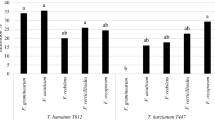Abstract
Forty-four fungal species belonging to 20 genera were isolated from 30 samples of qat leaves. The most frequent genera wereAspergillus, Alternaria, Penicillium, andCladosporium followed byFusarium, Drechslera, Chœtomium, andMucor. The most prevalent species in above genera wereAspergillus niger, A. flavus, A fumigatus, Alternaria alternata, Penicillium chrysogenum, P. citrinum, Cladosporium cladosporioides, andFusarium verticillioides. From these fungi, 17 species (39%) related to 7 genera (35%) proved to be true endophytes. Eleven out of 75 isolates were mycotoxigenic.A. alternata produced alternariol and alternariol monomethyl ether whereasA. flavus produced aflatoxins B1 and B2. Ochratoxin A, sterigmatocystin, citrinin and T-2 toxin were produced byA. ochraceus, A. versicolor, P. citrinum andF. oxysporum, respectively. The presence of such toxigenic fungi associated with qat leaves is considered to be a threat to public health.
Similar content being viewed by others
References
Abdel-Fattah H.M., Moubasher A.H., Abdel-Hafez S.I.I.: Fungus flora of root and leaf surface of broad-bean cultivated in Oases, Egypt.Naturalia monspeliensia Ser. Bot.27, 167–177 (1977).
Abdel-Hafez S.I.I.: Phyllosphere and phylloplane fungi of wheat cultivated in Saudi-Arabia.Mycopathology75, 33–38 (1985a).
Abdel-Hafez S.I.I.: Leaf surface fungi ofArgemone mexicana growing in Saudi-Arabia.Cryp. Mycol.6, 69–78 (1985b).
Abdel-Hafez S.I.I., El-Maghraby O.: Seasonal fluctuations of root and leaf surface fungi ofZygophyllium coccineum growing in Wadi Bir-El-Din, eastern desert, Egypt.Abhath Al-Yarmouk1, 107–125 (1992).
Abdel-Wahab A.M.: Phyllosphere microflora of some Egyptian plants.Folia Microbiol.20, 236–245 (1975).
Al-Attas O.H.: Qut: medicinal constituent and its effect on human health, pp. 125–128 inAl Qat. (In Arabic) Algamahier Press, Beirut 1982.
Alhubaishi A.A.A., Abdel-Kader M.I.A.: Phyllosphere and phylloplane fungi of qat in Sana'a, Yemen Arab Republic.J. Basic Microbiol.31, 83–89 (1991).
Allen N.K., Microcha C.J., Aakhus-Allen S., Bitgood J.J., Weaver G., Bates F.: Effects of dietary zearalenone on reproduction in chickens.Poultry Sci.60, 1165–1174 (1981).
Al-Meshal I.A., Ageel A.M., Tariq M., Parmer N.S.: The gastric antiulcer activity of Khat (Catha edulisForsh.).Res. Commun. Subst. Abuse5, 107 (1983).
Aoad: Exploratory Study on Ghat Phenomenon in Yemen Arab Republic and Peoples' Democratic Republic of Yemen. (In Arabic with an English summary) AOAD Press, Khartoum 1983.
Booth C.:Fusarium. Laboratory Guide to the Identification of Major Species. Commonwealth Mycological Institute, Kew (Surrey) England 1977.
Dahmash A.M.A.: Autecological study onCatha edulis in Yemen.MSc Thesis. Sana'a University, Yemen 1996.
Davis N.D., Diener M.L.: Mycotoxins, pp. 397–400 in L.R. Becuhat (Ed.):Food and Beverage Mycology. AVI Publishing Co., Westport (CT) 1978.
Dickinson C.H.: Fungal colonization ofPisum leaves.Can. J. Bot.45, 915–927 (1967).
Dimenna M.E., Parle J.N.: Moulds on leaves of perennial rye grass and white clover.New Zealand. J. Agric. Res.13, 51–68 (1970).
Domsch K.W., Gams W., Anderson T.H.:Compendium of Soil Fungi. Academic Press, New York 1980.
Ellis M.B.:Dematiaceous Hyphomycetes. Commonwealth Mycological Institute, Kew (Surrey), England 1971.
Ellis M.B.:More Dematiaceous Hyphomycetes. Commonwealth Mycological Institute, Kew (Surrey), England 1976.
Erkisson M., Ghani N.A., Kristiansson B.: Khat chewing during pregnancy—effect upon the offspring and some characteristics of the chewers.East Afr. Med. J.2, 106–110 (1991).
Gimeno A.: Thin layer chromatographic determination of aflatoxins, ochratoxins, sterigmatocystin, zearalenone, citrinin, T-2 toxin, diacetoxyscripenol, penicillic acid, patulin, and penitrem A.J. Assoc. Offic. Anal. Chem.62, 579–585 (1979).
Hald B.M., Hudson H.J.: Micro fungi (Ascomycetes, Basidiomycetes, Phycomycetes, Fungi imperfecti) onFagus sylvatica. I. The microfungal succession.Trans. Brit. Mycol. Soc.49, 185–192 (1966).
Hald B., Krogh P.: Analysis and chemical confirmation of citrinin in barley.J. Assoc. Offic. Anal. Chem.56, 1440–1443 (1973).
Hasan H.A.H.: Studies on toxigenic fungi in roasted foodstuff (salted seed) and halotolerant activity of emodin-producingAspergillus wentii.Folia Microbiol.43, 383–392 (1998).
Kalix P.: Khat, scientific knowledge and policy issues.Brit. J. Addict.82, 47 (1987).
Krikorian A.: A'Khat and its use, a historical perspective.J. Ethnopharm.12, 115 (1984).
Krogh P., Elling F., Hald B., Julling B., Petersen V.E., Shadhauge E., Svendsen C.K.: Experimental avian nephropathy.Acta Pathol. Microbiol. Scand. Sect. A Pathol.84, 215–221 (1976).
Nirenberg H.I.: Identification of fusaria occurring in Europe on cereals and potatoes, pp. 170–193 in J. Chelkowski (Ed.):Fusarium: Mycotoxins, Taxonomy and Pathogenicity. Elsevier Sci. Publ., Amsterdam 1989.
Pitt J.I.:The Genus Penicilliumand Its Teleomorphic States Eupenicilliumand Talaromyces. Academic Press, London 1979.
Pugh G.J.F., Mulder J.: Mycoflora associated withTypha latifolia.Trans. Brit. Mycol. Soc.57, 276–282 (1971).
Raper K.B., Pennell D.I.:The genus Aspergillus. Williams & Wilkins, Baltimore 1975.
Raper K.B., Thom C.:A Manual of the Penicillia. Williams & Wilkins, Baltimore 1949.
Sinha S.: The mycoflora on leaves ofCapsicum annuum L.,Solanum melonga L.,Solanum tuberosum L., andLycopersicum esculentumMill. pp. 175–189 in T.F. Preece, C.H. Dikinson:Ecology of Leaf Surface Micro-Organisms. Academic Press, London 1971.
Smith N.R., Dawson V.T.: The bacteriostatic action of rose bengal in media used for the plate count of soil fungi.Soil Sci.158, 467–471 (1944).
Taylor A.: The chemistry and biochemistry of sporidesmin and other 2,5-epidithia-3,6-dioxopiperazines, pp. 69–107 in R.I. Mateles, G.N. Wogan:Biochemistry of Some Food-Born Microbial Toxins. Massachusetts Inst. Technol. Press, Cambridge (MA) 1967.
United Nations; Economic and Social Council: Qat in Yemen.UN Rep. E/ESCWA/AGR10, 2 (1993).
Visconti A., Logrieco A., Bottalico A.: Natural occurrence ofAlternaria mycotoxins in olives, their production and possible transfer into the oil.Food Addit. Contam.13, 323–330 (1986).
Wyatt R.D., Colwell W.M., Hamilton P.B., Burmeiser H.R.: Neutral disturbances in chickens caused by dietary T-2 toxin.Appl. Microbiol.26, 757–761 (1973).
Author information
Authors and Affiliations
Rights and permissions
About this article
Cite this article
Mahmoud, AL.E. Mycotoxin-producing potential of fungi associated with qat (Catha edulis) leaves in yemen. Folia Microbiol 45, 452–456 (2000). https://doi.org/10.1007/BF02817620
Received:
Issue Date:
DOI: https://doi.org/10.1007/BF02817620




